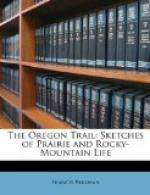He had been on the Arkansas, and there he had seen six great war parties of whites. He had never believed before that the whole world contained half so many white men. They all had large horses, long knives, and short rifles, and some of them were attired alike in the most splendid war dresses he had ever seen. From this account it was clear that bodies of dragoons and perhaps also of volunteer cavalry had been passing up the Arkansas. The Stabber had also seen a great many of the white lodges of the Meneaska, drawn by their long-horned buffalo. These could be nothing else than covered ox-wagons used no doubt in transporting stores for the troops. Soon after seeing this, our host had met an Indian who had lately come from among the Comanches. The latter had told him that all the Mexicans had gone out to a great buffalo hunt. That the Americans had hid themselves in a ravine. When the Mexicans had shot away all their arrows, the Americans had fired their guns, raised their war-whoop, rushed out, and killed them all. We could only infer from this that war had been declared with Mexico, and a battle fought in which the Americans were victorious. When, some weeks after, we arrived at the Pueblo, we heard of General Kearny’s march up the Arkansas and of General Taylor’s victories at Matamoras.
As the sun was setting that evening a great crowd gathered on the plain by the side of our tent, to try the speed of their horses. These were of every shape, size, and color. Some came from California, some from the States, some from among the mountains, and some from the wild bands of the prairie. They were of every hue—white, black, red, and gray, or mottled and clouded with a strange variety of colors. They all had a wild and startled look, very different from the staid and sober aspect of a well-bred city steed. Those most noted for swiftness and spirit were decorated with eagle-feathers dangling from their manes and tails. Fifty or sixty Dakotas were present, wrapped from head to foot in their heavy robes of whitened hide. There were also a considerable number of the Cheyenne, many of whom wore gaudy Mexican ponchos swathed around their shoulders, but leaving the right arm bare. Mingled among the crowd of Indians were a number of Canadians, chiefly in the employ of Bisonette; men, whose home is in the wilderness, and who love the camp fire better than the domestic hearth. They are contented and happy in the midst of hardship, privation, and danger. Their cheerfulness and gayety is irrepressible, and no people on earth understand better how “to daff the world aside and bid it pass.” Besides these, were two or three half-breeds, a race of rather extraordinary composition, being according to the common saying half Indian, half white man, and half devil. Antoine Le Rouge was the most conspicuous among them, with his loose pantaloons and his fluttering calico skirt. A handkerchief was bound round his head to confine his black snaky hair, and his small eyes




